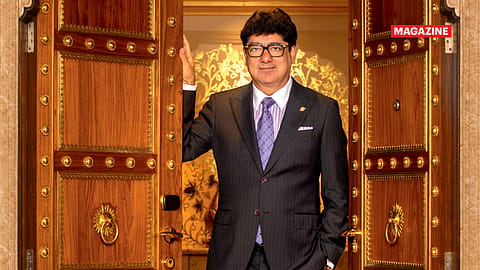Luxury is in its infancy in India, but is growing, says IHCL’s Puneet Chhatwal
The IHCL chief’s journey of reinventing luxury with Taj hotels has been remarkable.

This story belongs to the Fortune India Magazine global-brands-indian-sheen issue.
INDIAN HOTELS, especially the Taj brand, has always symbolised luxury in India. As someone who has been keenly watching this space, how do you think luxury has evolved in India?
Luxury is in its infancy in India, but it is growing. The reason for that is, for so many years we were more like a savings economy. Luxury was limited to weddings and education or may be a good house in a good location. The real need, demand, and quest for luxury started more or less during the Covid-19 pandemic. That’s when the generation that has all the disposable income started indulging in luxury more.
Secondly, India has been changing and evolving strongly in the past 10 years. There has been an influx of international luxury brands in India. Indians are also travelling abroad a lot more, so their awareness levels are increasing. Also, there is growth in the economy, there is a general feel-good factor. I believe senior executives and startup founders are indulging a lot more in luxury. Earlier, if there were 10 million luxury consumers, today there are easily 50-100 million. (2)As a percentage of the total population, luxury consumers would hardly be 2-3%, but it’s actually quite big — as big as the total population of a small country in Europe.
The Indian luxury market has been especially active in the past couple of years. One not only sees an influx of leading international brands, but also new business models. What kind of conversations do you have with luxury brand CEOs, since Taj is a popular luxury retail destination?
It’s again reflective of the way India has evolved. Earlier, luxury brands were visible only in the luxury hotels of India. Today, with the growth of shopping malls, a lot of these brands have moved into these spaces. But the number of brands has increased. So, we don’t have empty shops. That shows how luxury brands have grown, and demand is higher than supply.
The go-to-market strategy of global luxury brands has also evolved. Earlier, brands used to invest [in India] themselves; today, most of them are controlled by conglomerates such as Reliance Industries and Aditya Birla Fashion and Retail Ltd. The belief of Indian business houses that they can take on a brand and grow it, is immense. They understand the needs of the market much better than anybody else. At the same time, Indian luxury brands and designer labels have become strong. Taj, year after year, is getting rated as India’s strongest brand across sectors. We partnered with designer Sabyasachi a long time ago to do ‘cinema suites’ in London and we might partner with him to do many more suites in India, because Sabyasachi is a global fashion icon today. Tarun Tahiliani is doing the Taj in Ayodhya. He is going to do 29 presidential villas.
Unfortunately, today it’s only in hospitality that India features, maybe because of the way we conduct ourselves, the warmth of the hospitality we offer. But I do see a lot of other brands from India making it to the global top from the consumer side.
More Stories from this Issue
You just talked about Indian designer labels being acknowledged globally. There are many more luxury brands from India getting ready to go global. What kind of a mindset change do these brands need to appeal to international audiences?
Each brand needs to find its own niche, strategy, and execution plan. If your purpose is to be best in class and you want to create a space for yourself in that positioning, you also need the means. If you don’t have it, you will not get there. The India of yesterday didn’t provide you the means, but the India of today provides you the means. There is private equity available, there is venture capital available. There are large business houses that are willing to put the money behind people who have the talent, the drive, and the vision to make something out of it. You need the combination of all three and the ultimate goal to be the best in class. Then you can do the test within your own country and spread globally.
Different brands have different strategies and different markets have different entry barriers. Ultimately, the art of execution is the most important. You can have the best idea in the world, but if not executed properly it will not work well. You can have the best product in the world, but if not executed well it will not work.
Picking up the right market, the right business model, [and] the right strategic initiatives is the way forward. We will have a minimum of five luxury brands if not 10 that will make it to the global ranking in consumer businesses.
(INR CR)
Soon after you took over, you embarked on the journey of reinventing Taj and other brands. Though Taj was always a symbol of Indian luxury, it did not appeal to the younger audience. What did you do to regain the glory of the Taj brand?
I don’t agree with Taj not appealing to the younger generation. That’s not correct. Taj has always been dil se (from the heart) and people have stayed with us for generations. We made a few bold moves (launching business hotel brand, Vivanta and value brand, Ginger) in the early 2000s and then the world turned upside down — there was the global financial crisis and thereafter the backbone of Taj in those days, the Taj Mahal Palace in Colaba, fell victim to the 26/11 attack. That put us in a loss-making spiral from 2008-17.
During this journey when we were short of money, a lot of Taj’s classic properties (for reasons that may be relevant at that point of time because they didn’t see the required revenue contribution) got downgraded to other brands (the likes of Holiday Village in Goa, Fort Aguada Goa and Fisherman’s Cove, Mahabalipuram). The first job was how to upgrade them back to the old glory, which together with the 20-30 hotels we signed, immediately brought Taj to a 75-plus portfolio. These hotels started performing and our belief grew that we could do more and better. That took us to the next big leap—today, Taj has a portfolio of close to 100 hotels, it is tripling of [the] portfolio, despite two years of Covid. Taj was able to create that magic and become… more than a backbone, like a pillar that created a platform for the success of other brands.
The other bold move we took was instead of reinventing our iconic F&B brands each time we opened a hotel, why not make them the ambassadors of Taj, and also ambassadors of their own brand. So, House of Ming made a journey to London. House of Ming also became a restaurant in Patna or Bhopal. Similarly, we introduced new concepts and polished the old ones. The reimagination of The Chambers happened. The Chambers always had the who’s who of India, but over the years somehow it had got stuck in time. So, we redeveloped The Chambers in Delhi, doubled its size. We added The Chambers at the West End in Bengaluru, in Hyderabad, London, and Dubai. We are now renovating The Chambers in Taj Mahal Palace in Mumbai, that will create a new luxury brand within the brand. The Chambers was always the most recognised and respected private membership club supporting Taj, but it was never a brand in itself.
So, you need to keep reimagining and reinventing yourself with time to address the needs of your consumer, (3)without changing your core. The core is what your forefathers created, they gave you the culture and the core includes your values.
How does the economics of a luxury business work? Considering that luxury is rare and one of its kind, does it generate higher margins?
Let’s talk about luxury hotels. If you do a hotel in the other side of the spectrum (value) and if it is done well, by not wasting money and doing what people are known to pay for, the margins will be higher. (4)The risk would be less because it would be a less fixed-cost intensive model. But we are very blessed in Asia in general, and India in particular, to drive luxury and über-luxury margins close to 50%. Such high margins don’t work outside of India.
But managing such high margins in the long term wouldn’t be easy for a luxury brand, as in the next 10-15 years, labour costs and fixed costs will increase. The more you grow towards being the Top 5 economies in the world, the more you get established there, your cost structure will also follow.
Today, are the margins of Taj higher than those of Vivanta and Ginger?
It’s not fully accurate. When you say über-luxury — palaces, safaris, some of the key assets — the competitive advantage of Taj is that it has the ability to charge more and more versus the cost to service. Your competitive advantage is derived from two things — one is something you have that others don’t. You have palaces that others don’t. It’s not been easy to copy the palaces. The second is your ability to drive margins because you have higher ability to charge competitive cost to service. Taj definitely drives superior margins in India, around 45-50% on a standalone basis and internationally higher than 35%. It is kind of industry-leading in terms of its ability to deliver margins.
